technical data SKODA OCTAVIA 2005 1.G / (1U) Owners Manual
[x] Cancel search | Manufacturer: SKODA, Model Year: 2005, Model line: OCTAVIA, Model: SKODA OCTAVIA 2005 1.G / (1U)Pages: 315, PDF Size: 11.8 MB
Page 186 of 315
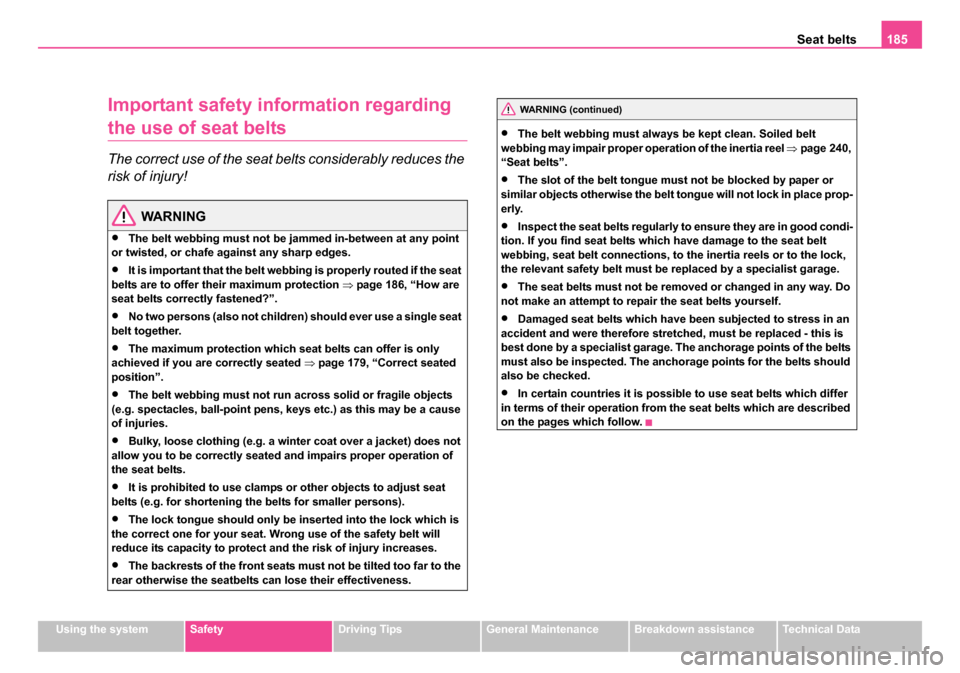
Seat belts185
Using the systemSafetyDriving TipsGeneral MaintenanceBreakdown assistanceTechnical Data
Important safety information regarding
the use of seat belts
The correct use of the seat belts considerably reduces the
risk of injury!
WARNING
•The belt webbing must not be jammed in-between at any point
or twisted, or chafe against any sharp edges.
•It is important that the belt webb ing is properly routed if the seat
belts are to offer their maximum protection ⇒page 186, “How are
seat belts correctly fastened?”.
•No two persons (also not children) should ever use a single seat
belt together.
•The maximum protection which seat belts can offer is only
achieved if you are correctly seated ⇒page 179, “Correct seated
position”.
•The belt webbing must not run across solid or fragile objects
(e.g. spectacles, ball-point pens, keys etc.) as this may be a cause
of injuries.
•Bulky, loose clothing (e.g. a winter coat over a jacket) does not
allow you to be correctly seated and impairs proper operation of
the seat belts.
•It is prohibited to use clamps or other objects to adjust seat
belts (e.g. for shortening the belts for smaller persons).
•The lock tongue should only be inserted into the lock which is
the correct one for your seat. Wrong use of the safety belt will
reduce its capacity to protect and the risk of injury increases.
•The backrests of the front seats must not be tilted too far to the
rear otherwise the seatbelts can lose their effectiveness.
•The belt webbing must always be kept clean. Soiled belt
webbing may impair proper operation of the inertia reel ⇒page 240,
“Seat belts”.
•The slot of the belt tongue must not be blocked by paper or
similar objects otherwise the belt tongue will not lock in place prop-
erly.
•Inspect the seat belts regularly to ensure they are in good condi-
tion. If you find seat belts which have damage to the seat belt
webbing, seat belt connections, to the inertia reels or to the lock,
the relevant safety belt must be replaced by a specialist garage.
•The seat belts must not be removed or changed in any way. Do
not make an attempt to repair the seat belts yourself.
•Damaged seat belts which have been subjected to stress in an
accident and were therefore stretched, must be replaced - this is
best done by a specialist garage. The anchorage points of the belts
must also be inspected. The anchorage points for the belts should
also be checked.
•In certain countries it is possible to use seat belts which differ
in terms of their operation from the seat belts which are described
on the pages which follow.
WARNING (continued)
s24s.book Page 185 Thursday, November 24, 2005 12:27 PM
Page 188 of 315
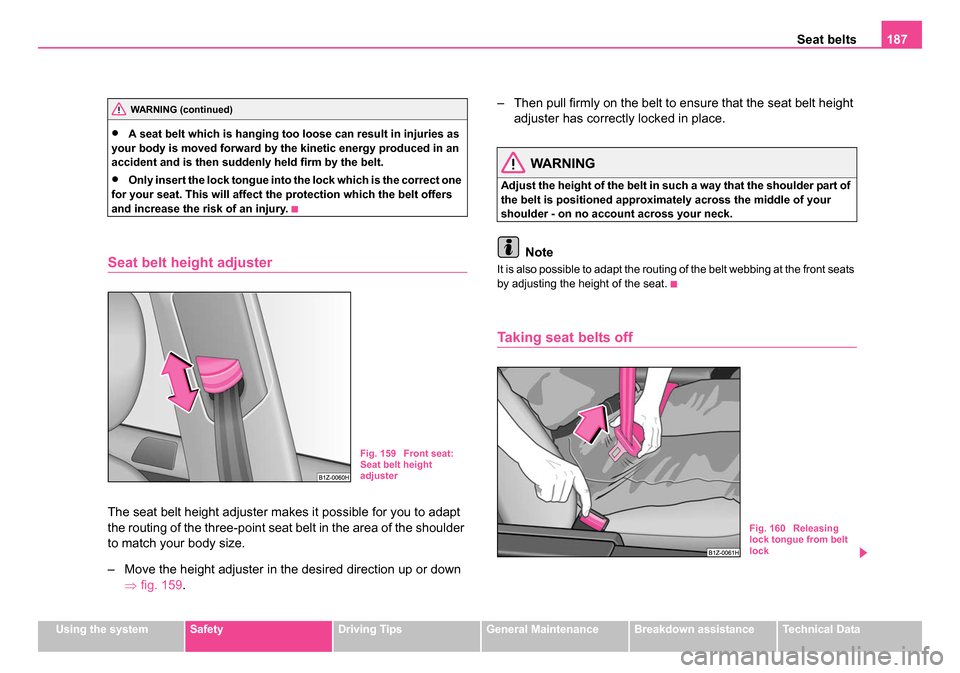
Seat belts187
Using the systemSafetyDriving TipsGeneral MaintenanceBreakdown assistanceTechnical Data
•A seat belt which is hanging too loose can result in injuries as
your body is moved forward by the kinetic energy produced in an
accident and is then suddenly held firm by the belt.
•Only insert the lock tongue into the lock which is the correct one
for your seat. This will affect the protection which the belt offers
and increase the risk of an injury.
Seat belt height adjuster
The seat belt height adjuster makes it possible for you to adapt
the routing of the three-point seat belt in the area of the shoulder
to match your body size.
– Move the height adjuster in the desired direction up or down ⇒fig. 159 . – Then pull firmly on the belt to ensure that the seat belt height
adjuster has correctly locked in place.
WARNING
Adjust the height of the belt in such a way that the shoulder part of
the belt is positioned approximately across the middle of your
shoulder - on no account across your neck.
Note
It is also possible to adapt the routing of the belt webbing at the front seats
by adjusting the height of the seat.
Taking seat belts off
WARNING (continued)
Fig. 159 Front seat:
Seat belt height
adjuster
Fig. 160 Releasing
lock tongue from belt
lock
s24s.book Page 187 Thursday, November 24, 2005 12:27 PM
Page 190 of 315
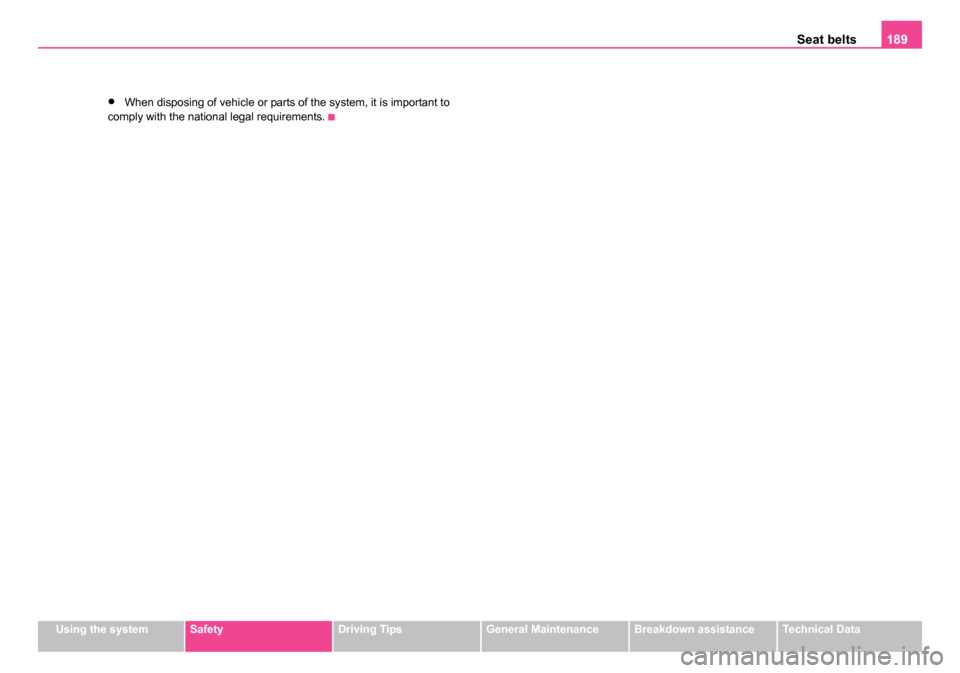
Seat belts189
Using the systemSafetyDriving TipsGeneral MaintenanceBreakdown assistanceTechnical Data
•When disposing of vehicle or parts of the system, it is important to
comply with the national legal requirements.
s24s.book Page 189 Thursday, November 24, 2005 12:27 PM
Page 192 of 315

Airbag system191
Using the systemSafetyDriving TipsGeneral MaintenanceBreakdown assistanceTechnical Data
•The protective function of the airbag system is sufficient for
only one accident. The airbag system must then be replaced if the
airbag has been deployed.
•The airbag system needs no maintenance during its working
life.
•The service life of the airbag system is 15 years from the date of
manufacture of the vehicle. Have the airbag system replaced by a
specialist garage after this period. If the modules of the system are
replaced before the expiry of the term (e.g. because of an accident),
the new change interval has to be entered in the service brochure.
•If you sell your car, please hand over the complete vehicle docu-
mentation to the new owener. Please note that the documents
relating to the possibility of deactivating the front passenger airbag
are also part of the vehicle documents!
•If the vehicle or individual parts of the airbag system are
scrapped, it is essential to observe the relevant safety precautions.
Škoda dealers are familiar with these regulations.
•When disposing of vehicle or parts of the airbag system, it is
important to comply with th e national legal requirements.
When are the airbags deployed?
The airbag system is designed in such a way that the driver airbag and the
front passenger airbag* are deployed in the event of a frontal collision of
major severity.
In the case of a violent side crash , the side airbag* on the side of the car
at which the collision occurs, is deployed together with the head airbag*.
In certain accident situations it is possible that both the front as well as the
side airbags and the relevant head airbag are deployed at the same time. The airbags
are not deployed in the case of minor frontal and side colli-
sions, in the case of rear-end collisions and vehicle rollover.
Deployment factors
It is not possible to state globally which deployment conditions apply to the
airbag system in every situation as the circumstances which exist in the
case of accidents vary greatly. An important role in this case, for example,
is played by factors such as the type of object against which the vehicle
impacts (hard, soft), the angle of impact, the vehicle speed etc.
A decisive factor for the deployment of the airbags is the deceleration
which occurs during a collision. The control unit analyses the nature of the
collision and activates the relevant restraint system. If the vehicle decel-
eration which occurs and is measured during the collision remains below
the prescribed reference values specified in the control unit, the airbags
are not deployed although the vehicle may well suffer severe damage to
the bodywork as a consequence of the accident.
The airbags are not deployed if:
•ignition off,
•a minor frontal collision,
•a minor side collision,
•a rear-end collision,
•rollover.
Note
•A grey white, non harmful gas is released when airbag is inflated. This
is perfectly normal and is not an indication of a fire in the vehicle.
•The dash panel must be replaced after the front passenger airbag has
been deployed.
•In the event of an accident in which the airbags are deployed:
− The interior lighting comes on (if the switch for the interior light is in
the door contact position),
WARNING (continued)
s24s.book Page 191 Thursday, November 24, 2005 12:27 PM
Page 194 of 315
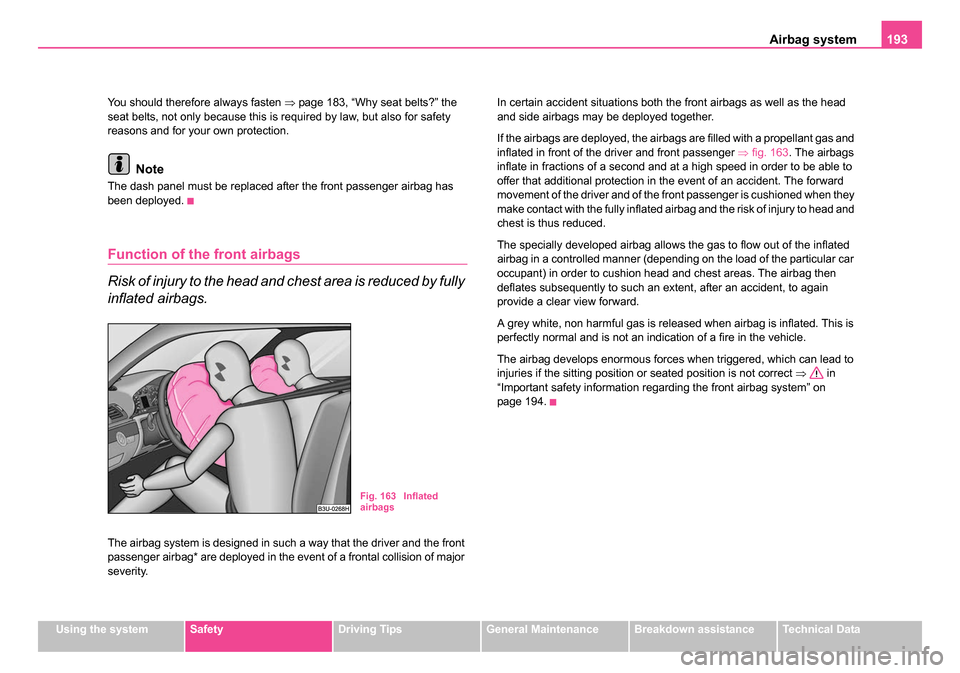
Airbag system193
Using the systemSafetyDriving TipsGeneral MaintenanceBreakdown assistanceTechnical Data
You should therefore always fasten
⇒page 183, “Why seat belts?” the
seat belts, not only because this is required by law, but also for safety
reasons and for your own protection.
Note
The dash panel must be replaced after the front passenger airbag has
been deployed.
Function of the front airbags
Risk of injury to the head and chest area is reduced by fully
inflated airbags.
The airbag system is designed in such a way that the driver and the front
passenger airbag* are deployed in the event of a frontal collision of major
severity. In certain accident situations both the front airbags as well as the head
and side airbags may be deployed together.
If the airbags are deployed, the airbags are filled with a propellant gas and
inflated in front of the driver and front passenger
⇒fig. 163 . The airbags
inflate in fractions of a second and at a high speed in order to be able to
offer that additional protection in the event of an accident. The forward
movement of the driver and of the front passenger is cushioned when they
make contact with the fully inflated airbag and the risk of injury to head and
chest is thus reduced.
The specially developed airbag allows the gas to flow out of the inflated
airbag in a controlled manner (depending on the load of the particular car
occupant) in order to cushion head and chest areas. The airbag then
deflates subsequently to such an extent, after an accident, to again
provide a clear view forward.
A grey white, non harmful gas is released when airbag is inflated. This is
perfectly normal and is not an indication of a fire in the vehicle.
The airbag develops enormous forces when triggered, which can lead to
injuries if the sitting position or seated position is not correct ⇒ in
“Important safety information regarding the front airbag system” on
page 194.
Fig. 163 Inflated
airbags
s24s.book Page 193 Thursday, November 24, 2005 12:27 PM
Page 196 of 315
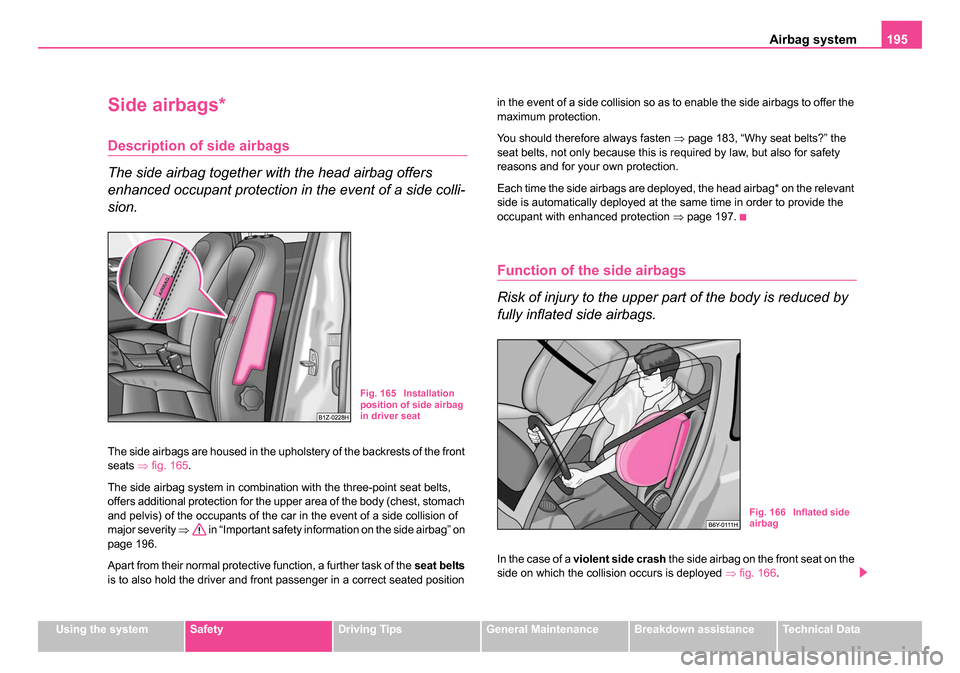
Airbag system195
Using the systemSafetyDriving TipsGeneral MaintenanceBreakdown assistanceTechnical Data
Side airbags*
Description of side airbags
The side airbag together with the head airbag offers
enhanced occupant protection in the event of a side colli-
sion.
The side airbags are housed in the upholstery of the backrests of the front
seats ⇒fig. 165 .
The side airbag system in combination with the three-point seat belts,
offers additional protection for the upper area of the body (chest, stomach
and pelvis) of the occupants of the car in the event of a side collision of
major severity ⇒ in “Important safety information on the side airbag” on
page 196.
Apart from their normal protective function, a further task of the seat belts
is to also hold the driver and front passenger in a correct seated position in the event of a side collision so as to enable the side airbags to offer the
maximum protection.
You should therefore always fasten
⇒page 183, “Why seat belts?” the
seat belts, not only because this is required by law, but also for safety
reasons and for your own protection.
Each time the side airbags are deployed, the head airbag* on the relevant
side is automatically deployed at the same time in order to provide the
occupant with enhanced protection ⇒page 197.
Function of the side airbags
Risk of injury to the upper part of the body is reduced by
fully inflated side airbags.
In the case of a violent side crash the side airbag on the front seat on the
side on which the collision occurs is deployed ⇒fig. 166 .
Fig. 165 Installation
position of side airbag
in driver seat
Fig. 166 Inflated side
airbag
s24s.book Page 195 Thursday, November 24, 2005 12:27 PM
Page 198 of 315
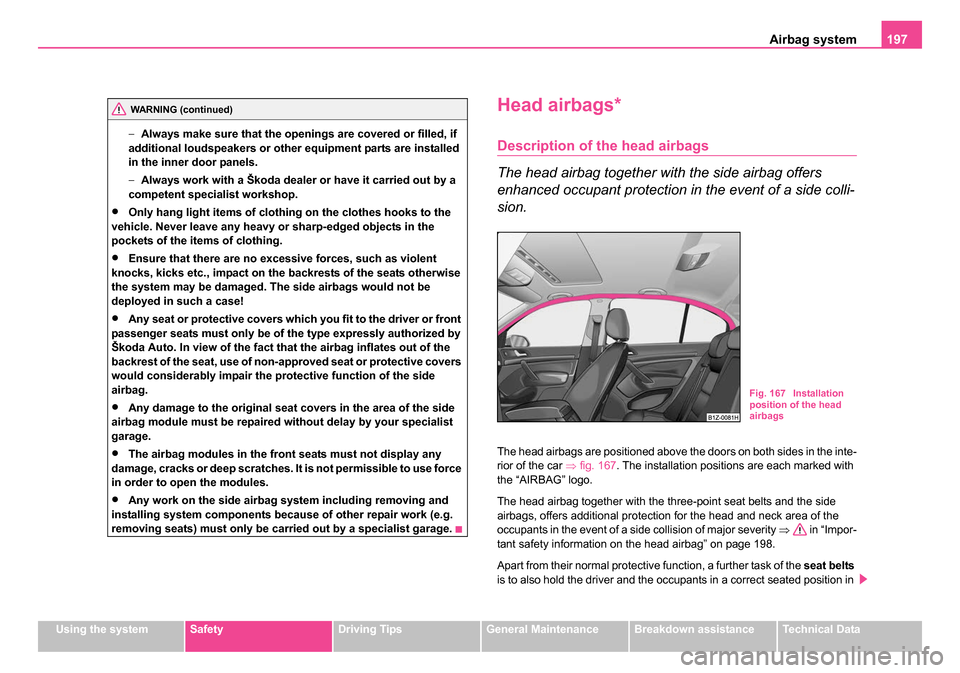
Airbag system197
Using the systemSafetyDriving TipsGeneral MaintenanceBreakdown assistanceTechnical Data
−
Always make sure that the openings are covered or filled, if
additional loudspeakers or other equipment parts are installed
in the inner door panels.
− Always work with a Škoda dealer or have it carried out by a
competent specialist workshop.
•Only hang light items of clothing on the clothes hooks to the
vehicle. Never leave any heavy or sharp-edged objects in the
pockets of the items of clothing.
•Ensure that there are no excessive forces, such as violent
knocks, kicks etc., impact on the backrests of the seats otherwise
the system may be da maged. The side airbags would not be
deployed in such a case!
•Any seat or protective covers which you fit to the driver or front
passenger seats must only be of the type expressly authorized by
Škoda Auto. In view of the fact that the airbag inflates out of the
backrest of the seat, use of non-approved seat or protective covers
would considerably impair the protective function of the side
airbag.
•Any damage to the original seat covers in the area of the side
airbag module must be repaired without delay by your specialist
garage.
•The airbag modules in the front seats must not display any
damage, cracks or deep scratches. It is not permissible to use force
in order to open the modules.
•Any work on the side airbag system including removing and
installing system components because of other repair work (e.g.
removing seats) must only be carried out by a specialist garage.
Head airbags*
Description of the head airbags
The head airbag together with the side airbag offers
enhanced occupant protection in the event of a side colli-
sion.
The head airbags are positioned above the doors on both sides in the inte-
rior of the car ⇒fig. 167 . The installation positions are each marked with
the “AIRBAG” logo.
The head airbag together with the three-point seat belts and the side
airbags, offers additional protection for the head and neck area of the
occupants in the event of a side collision of major severity ⇒ in “Impor-
tant safety information on the head airbag” on page 198.
Apart from their normal protective function, a further task of the seat belts
is to also hold the driver and the occupants in a correct seated position in
WARNING (continued)
Fig. 167 Installation
position of the head
airbags
s24s.book Page 197 Thursday, November 24, 2005 12:27 PM
Page 200 of 315
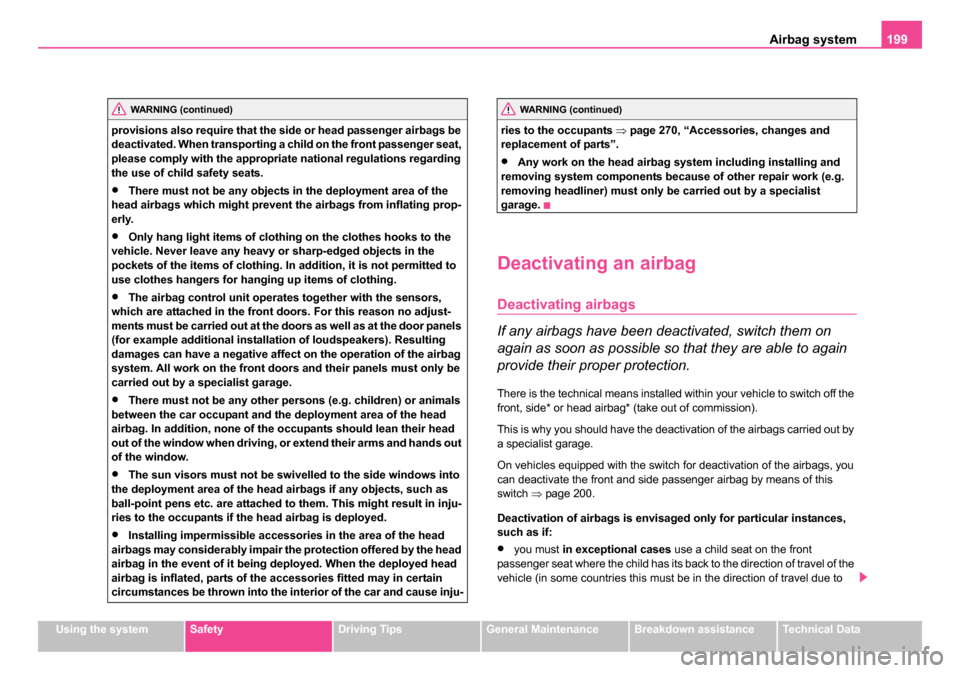
Airbag system199
Using the systemSafetyDriving TipsGeneral MaintenanceBreakdown assistanceTechnical Data
provisions also require that the side or head passenger airbags be
deactivated. When transporting a child on the front passenger seat,
please comply with the appropriate national regulations regarding
the use of child safety seats.
•There must not be any objects in the deployment area of the
head airbags which might prevent the airbags from inflating prop-
erly.
•Only hang light items of clothing on the clothes hooks to the
vehicle. Never leave any heavy or sharp-edged objects in the
pockets of the items of clothing. In addition, it is not permitted to
use clothes hangers for hanging up items of clothing.
•The airbag control unit operates together with the sensors,
which are attached in the front doors. For this reason no adjust-
ments must be carried out at the doors as well as at the door panels
(for example additional installation of loudspeakers). Resulting
damages can have a negative affect on the operation of the airbag
system. All work on the front doors and their panels must only be
carried out by a specialist garage.
•There must not be any other persons (e.g. children) or animals
between the car occupant and the deployment area of the head
airbag. In addition, none of the occupants should lean their head
out of the window when driving, or extend their arms and hands out
of the window.
•The sun visors must not be swivelled to the side windows into
the deployment area of the head airbags if any objects, such as
ball-point pens etc. are attached to them. This might result in inju-
ries to the occupants if the head airbag is deployed.
•Installing impermissible accessories in the area of the head
airbags may considerably impair the protection offered by the head
airbag in the event of it being deployed. When the deployed head
airbag is inflated, parts of the accessories fitted may in certain
circumstances be thrown into the interior of the car and cause inju- ries to the occupants
⇒page 270, “Accessories, changes and
replacement of parts”.
•Any work on the head airbag system including installing and
removing system components because of other repair work (e.g.
removing headliner) must only be carried out by a specialist
garage.
Deactivating an airbag
Deactivating airbags
If any airbags have been deactivated, switch them on
again as soon as possible so that they are able to again
provide their proper protection.
There is the technical means installed within your vehicle to switch off the
front, side* or head airbag* (take out of commission).
This is why you should have the deactivation of the airbags carried out by
a specialist garage.
On vehicles equipped with the switch for deactivation of the airbags, you
can deactivate the front and side passenger airbag by means of this
switch ⇒page 200.
Deactivation of airbags is envisaged only for particular instances,
such as if:
•you must in exceptional cases use a child seat on the front
passenger seat where the child has its back to the direction of travel of the
vehicle (in some countries this must be in the direction of travel due to
WARNING (continued)WARNING (continued)
s24s.book Page 199 Thursday, November 24, 2005 12:27 PM
Page 202 of 315
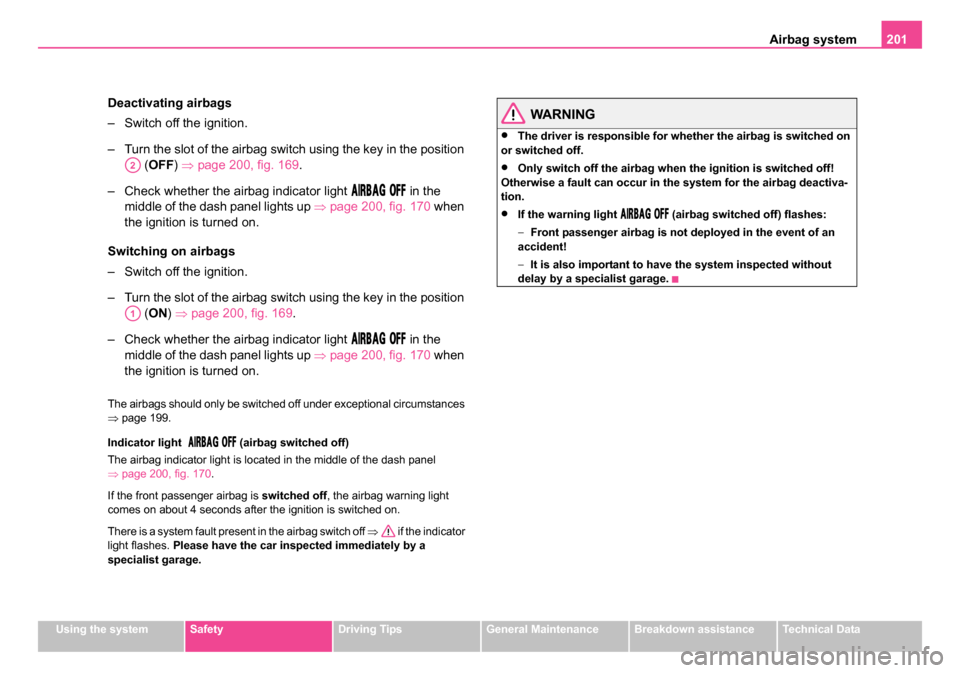
Airbag system201
Using the systemSafetyDriving TipsGeneral MaintenanceBreakdown assistanceTechnical Data
Deactivating airbags
– Switch off the ignition.
– Turn the slot of the airbag switch using the key in the position
(OFF ) ⇒ page 200, fig. 169 .
– Check whether the airbag indicator light
in the
middle of the dash panel lights up ⇒page 200, fig. 170 when
the ignition is turned on.
Switching on airbags
– Switch off the ignition.
– Turn the slot of the airbag switch using the key in the position (ON ) ⇒ page 200, fig. 169.
– Check whether the airbag indicator light
in the
middle of the dash panel lights up ⇒page 200, fig. 170 when
the ignition is turned on.
The airbags should only be switched off under exceptional circumstances
⇒ page 199.
Indicator light
(airbag switched off)
The airbag indicator light is located in the middle of the dash panel
⇒ page 200, fig. 170 .
If the front passenger airbag is switched off, the airbag warning light
comes on about 4 seconds after the ignition is switched on.
There is a system fault present in the airbag switch off ⇒ if the indicator
light flashes. Please have the car inspected immediately by a
specialist garage.
WARNING
•The driver is responsible for whether the airbag is switched on
or switched off.
•Only switch off the airbag when the ignition is switched off!
Otherwise a fault can occur in the system for the airbag deactiva-
tion.
•If the warning light (airbag switched off) flashes:
− Front passenger airbag is not deployed in the event of an
accident!
− It is also important to have the system inspected without
delay by a specialist garage.
A2
A1
s24s.book Page 201 Thursday, November 24, 2005 12:27 PM
Page 204 of 315

Transporting children safely 203
Using the systemSafetyDriving TipsGeneral MaintenanceBreakdown assistanceTechnical Data
otherwise this may result in injuries to the stomach and neck areas.
Comply with the national legal requirements.
•One should never carry children, and also not babies! - on one's
lap.
•You can transport a child safely in a suitable child safety seat
⇒ page 206, “Child seat”!
•Only one child may be fastened with a seat belt into a child
safety seat.
•Never leave the child sitting unattended in the seat.
•Certain outside climatic conditions can cause life-threatening
temperatures in the vehicle.
•Never allow your child to be tran sported in a vehicle without the
use of a suitable restraint system.
•Children should also never stand up in a vehicle or kneel on the
seats when the vehicle is moving. In the event of an accident the
child will be thrown through the vehicle and may as a result suffer
fatal injuries, and also injure other occupants.
•Children are exposed to an increased risk of injury in the event
of an accident if they lean forward or adopt an incorrect seated
position when the vehicle is moving . This particularly applies to
children who are transported on the front passenger seat if the
airbag system deploys in the event of an accident. This can result
in severe or even fatal injuries.
•It is important that the belt webb ing is properly routed if the seat
belts are to offer their maximum protection ⇒page 186, “How are
seat belts correctly fastened?”. Pay particular attention to the
information provided by the manufacturer of the child safety seat
regarding correct routing of the belt. Seat belts which are not
correctly adjusted can themselves cause injuries even in minor
accidents.
•Safety belts must be checked to ensure that they are running
properly. One should also ensure that the belt is not damaged by
sharp-edged fittings.
•It is essential to always switch off ⇒page 199 the front
passenger airbag when attaching a child safety seat on the front
passenger seat where the child is seated with its back facing in
direction of travel (in some countries also when the child is facing
the direction of travel). If this is not done, there is a risk of the child
suffering severe or even fatal injuries if the front passenger airbag
is deployed. In certain countries national legal provisions also
require that the side or head passenger airbags be deactivated.
When transporting a child on the front passenger seat, please
comply with the appropriate national regulations regarding the use
of child safety seats.
WARNING (continued)WARNING (continued)
s24s.book Page 203 Thursday, November 24, 2005 12:27 PM